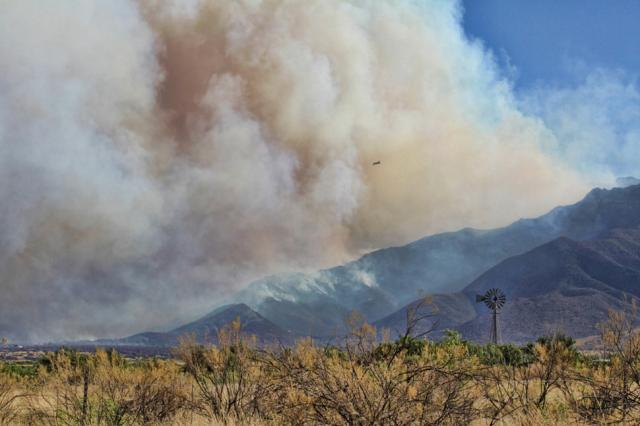Soil Erosion Control
after Wildfire
Quick Facts...
* The most immediate consequence of fire is the potential for soil erosion.
* Intense heat from fire can make the soil repel water, a condition called hydrophobicity.
* Landowners should take quick action to minimize erosion once it's safe to return to the property:
 > fell damaged trees to slow water runoff after rainfall;
> fell damaged trees to slow water runoff after rainfall;
 > create check dams in drainages using straw bales;
> create check dams in drainages using straw bales;
 > spread straw to protect the soil and reseeding efforts; and
> spread straw to protect the soil and reseeding efforts; and
 > use water bars to reduce soil erosion on roads.
> use water bars to reduce soil erosion on roads.
The potential for severe soil erosion is a consequence of wildfire because as a fire burns it destroys plant material and the litter layer. Shrubs, forbs, grasses, trees, and the litter layer break up the intensity of severe rainstorms. Plant roots stabilize the soil, and stems and leaves slow the water to give it time to percolate into the soil profile. Fire can destroy this soil protection. There are several steps to take to reduce the amount of soil erosion. A landowner, using common household tools and materials, can accomplish most of these methods in the aftermath of a wildfire.
Hydrophobic Soils
 In severe, slow-moving fires, the combustion of vegetative materials creates a gas that penetrates the soil profile. As the soil cools, this gas condenses and forms a waxy coating. This causes the soil to repel water - a phenomena called hydrophobicity. This hydrophobic condition increases the rate of water runoff. Percolation of water into the soil profile is reduced, making it difficult for seeds to germinate and for the roots of surviving plants to obtain moisture.
In severe, slow-moving fires, the combustion of vegetative materials creates a gas that penetrates the soil profile. As the soil cools, this gas condenses and forms a waxy coating. This causes the soil to repel water - a phenomena called hydrophobicity. This hydrophobic condition increases the rate of water runoff. Percolation of water into the soil profile is reduced, making it difficult for seeds to germinate and for the roots of surviving plants to obtain moisture.
 Hydrophobic soils do not form in every instance. Factors contributing to their formation are: a thick layer of litter before the fire; a severe slow-moving surface and crown fire; and coarse textured soils such as sand or decomposed granite. (Finely textured soils such as clay are less prone to hydrophobicity.)
Hydrophobic soils do not form in every instance. Factors contributing to their formation are: a thick layer of litter before the fire; a severe slow-moving surface and crown fire; and coarse textured soils such as sand or decomposed granite. (Finely textured soils such as clay are less prone to hydrophobicity.)
 The hydrophobic layer can vary in thickness. There is a simple test to determine if this water repellant layer is present:
The hydrophobic layer can vary in thickness. There is a simple test to determine if this water repellant layer is present:
 1. Place a drop of water on the exposed soil surface and wait a few moments. If the water beads up and does not penetrate the soil then it's hydrophobic.
1. Place a drop of water on the exposed soil surface and wait a few moments. If the water beads up and does not penetrate the soil then it's hydrophobic.
 2. Repeat this test several times, but each time remove a one-inch thick layer of the soil profile. Breaking this water repellant layer is essential for successful reestablishment of plants.
2. Repeat this test several times, but each time remove a one-inch thick layer of the soil profile. Breaking this water repellant layer is essential for successful reestablishment of plants.
 In addition, freezing and thawing, and animal activity will help break up the hydrophobic layer.
In addition, freezing and thawing, and animal activity will help break up the hydrophobic layer.
Erosion Control Techniques
Home/Land owners should avoid removing excessive plants, shrubs and trees from the landscape (except if they threaten personal safety or property). Rapid removal can accelerate soil erosion. Undertake defensive measures to ensure that soil erosion does not become severe.
 Your local Natural Resources Conservation Service (NRCS) has provided the following information to assist you in the restoration of your land after a wildfire.
Your local Natural Resources Conservation Service (NRCS) has provided the following information to assist you in the restoration of your land after a wildfire.






